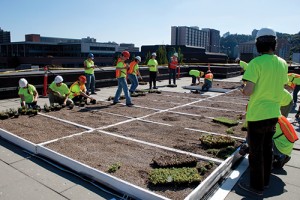New green roof installed on Cramer Hall
Austin Hudson, a graduate civil engineering student, would like to fly over Portland State and not be able to tell the Park Blocks from university building rooftops.

Miles Sanguinetti/VANGUARD STAFF
CONSTRUCTION on the ecoroof above Cramer Hall began Sept. 22.
“I’d like to see green roofs everywhere,” he said. That’s why he is part of a student group, Engineers Without Borders, that recently built a green roof on Cramer Hall.
The installation of the 1,920-square-foot green roof began Sept. 22. A crane lifted 20 planter boxes, sized 8 by 12 feet, and giant bags of soil onto the roof, making a living laboratory that will host many different classes.
Green roofs range from lightweight, 3-inch ground covers to human-accessible parks. The soil atop
Cramer Hall will not exceed 6 inches, and the plants will mostly be small grasses and succulents called sedums, a common ecoroof crop. Edible thyme and wild strawberries will make up 5 percent of the rooftop.
Theo Malone, a member of EWB, said Cramer Hall won’t be a food-producing rooftop garden, but that might be a goal for future green roof projects.
“Typically, ecoroofs aren’t food producing. Not yet,” Malone said. “I say ‘yet’ because someday they will be.” Malone is one of the few graduate students involved with the project.
“We will be testing native and nonnative plants side by side to determine their efficacy on ecoroofs [in Portland],” Malone explained.
Students will also determine what soil types are most effective and least expensive.
The soil in each planter box varies in unit weight—some have more organic matter and some are lighter and mixed with more perlite, a highly-permeable volcanic material common in store-bought potting soil.

Miles Sanguetti/VANGUARD STAFF
STUDENTS help build Cramer’s Hall new ecoroof.
Another benefit of green roofs is how they control stormwater runoff and help to prevent sewer system overflow—common in Portland until the completion of the $1.4 billion Big Pipe project last year.
The planter boxes have three main components that help control stormwater runoff. When it rains, water seeps through the soil and through a thin geosynthetic material beneath, which holds soil in but lets water out.
Below that is a waffle-like slab called a geomembrane. The geomembrane both protects the roof and allows water to drip freely from the boxes so it can trickle across the roof into storm drains.
The rate of flow will be slower having gone through the planter boxes, reducing the risk of sewer system overflow.
The water’s temperature will also be warmer, which is better for the waterways it will end up in.
“Fish don’t like water that is too cold,” Hudson said.
Along with the Big Pipe project, the City of Portland is hoping to control water flow with smaller projects like green roofs and bioswales—a mechanism that both controls the rate of flow into storm drains and filters out pollutants.
Because the weight of a green roof can exceed engineering limits, Cramer Hall had to be inspected first. The wall surrounding the rooftop is shorter than the Occupational Safety and Health Administration allows, so students are not allowed on the rooftop without Facilities and Planning supervision.
According to Hudson, green roofs cost anywhere from $5 to $25 per square foot. “We want to see how far we can go with a budget of $5 per square foot,” he said. EWB received a $5-per-square-foot budget from PSU’s Bureau of Environmental Services.
Additional funding from the Associated Students of Portland State University provides a short-term maintenance budget.
“Facilities and Planning was hesitant to let us do this,” Hudson said. He explained that they didn’t want to have to maintain the roof. Hudson said that because the goal is to make the roof maintenance-free, the department was pacified.
A common problem with student projects is maintenance. After students graduate, there is often no one to take over a project. Cramer Hall will be different because built into the project’s 10-year design life is an initiative to get new students and underclassmen involved. Hudson hopes they will not only carry forth the project, but be inspired to create other projects as well.
“[These projects] are empowering,” said Hudson. “For me, this makes going to school bearable. It is a creative outlet, it makes education feel important. After I graduated [with a bachelor’s degree] I didn’t feel ready to work. But you finish projects like this and you feel like you’ve
accomplished something.”








